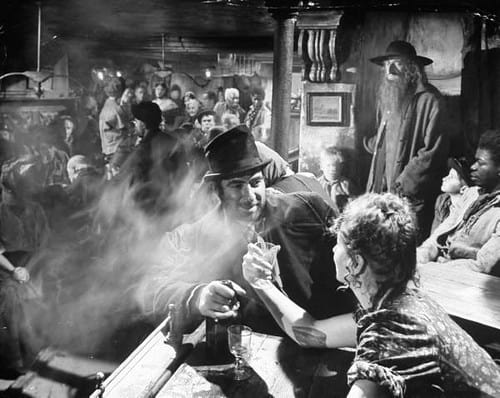Plot and Storyline
Oliver Twist is a classic novel written by Charles Dickens, first published in 1838. The story follows the life of an orphan named Oliver Twist and explores the social and economic hardships faced by the poor in 19th-century England. The novel begins with Oliver’s birth in a workhouse and chronicles his journey through various institutions and encounters with a range of characters, both benevolent and villainous.
Oliver’s early years are marked by mistreatment and neglect, as he endures harsh conditions in the workhouse and then faces abuse at the hands of Mr. Bumble, the parish beadle. After daring to ask for more food, Oliver is sold to an undertaker, Mr. Sowerberry, where he faces further hardship and humiliation. Eventually, Oliver runs away and makes his way to London.
In London, Oliver encounters a gang of child thieves led by the cunning Fagin and the brutal Bill Sikes. Unaware of their criminal activities, Oliver is reluctantly drawn into their world. However, Oliver’s inherently good nature and innocence prevent him from fully embracing a life of crime. He forms a bond with a kind-hearted prostitute named Nancy, who becomes conflicted between her loyalty to the gang and her affection for Oliver.
As the story unfolds, Oliver’s true identity is revealed, connecting him to characters from his past. Through a series of dramatic events and surprising twists, Oliver’s life takes a turn for the better, and he finds himself in the care of a compassionate benefactor. However, he becomes entangled in a web of secrets and lies that threaten his newfound happiness.
Characters
Oliver Twist is the novel’s protagonist and embodies the virtues of innocence, goodness, and resilience. Despite his difficult circumstances, Oliver remains pure-hearted and withstands the corrupting influences around him.
Fagin is a complex character who serves as the leader of the child thieves. He is portrayed as a manipulative and cunning figure, exploiting the vulnerability of orphaned children for his own gain.
Bill Sikes is a menacing and violent criminal who is responsible for some of the novel’s most dramatic and tragic moments. His brutish nature and disregard for human life make him a formidable antagonist.
Nancy is a sympathetic character who provides a glimpse of the potential for redemption within a morally compromised world. Her conflicted loyalties and ultimate sacrifice add depth and emotional resonance to the story.
Themes and Symbols
One of the central themes of Oliver Twist is the inherent goodness of the individual, even in the face of a corrupt and oppressive society. Oliver’s unwavering moral compass serves as a critique of the social conditions of the time, highlighting the inhumanity and hypocrisy of the upper classes.
The novel also explores the nature of identity and the impact of one’s upbringing on their character. Oliver’s true identity and noble lineage challenge the notion that a person’s worth is solely determined by their social status or circumstances of birth.
The symbol of the workhouse represents the dehumanizing effects of poverty and the oppressive systems that perpetuate inequality. Dickens uses vivid descriptions to evoke a sense of hopelessness and despair, emphasizing the need for social reform.
Writing Style
Charles Dickens is renowned for his vivid and descriptive writing style, which brings the characters and settings to life. His use of richly detailed descriptions and colorful language immerses the reader in the world of 19th-century England.
Dickens employs various literary techniques, such as irony, satire, and social commentary, to highlight the injustices and hypocrisies of the time. His skillful use of dialogue and dialects adds depth and authenticity to the characters, capturing the diversity of the urban environment.
The narrative structure of Oliver Twist is episodic, with each chapter presenting a distinct event or encounter in Oliver’s life. This structure allows Dickens to explore different facets of society and provides a comprehensive view of the challenges faced by the poor and marginalized.
Setting and Atmosphere
The setting of Oliver Twist plays a significant role in shaping the tone and mood of the novel. The dark and gritty streets of London create an atmosphere of danger and uncertainty, reflecting the harsh realities faced by the characters.
The time period of the story, set during the early 19th century, is characterized by widespread poverty, social inequality, and the Industrial Revolution. The contrast between the opulence of the upper classes and the squalor of the lower classes is a recurring motif, underscoring the stark divisions within society.
Historical, Social, or Political Context
Oliver Twist was written during a time of significant social and political change in England. The novel reflects the author’s concerns about the treatment of the poor, the shortcomings of the workhouse system, and the moral decay of society.
Dickens criticizes the Poor Laws of the time, which perpetuated the cycle of poverty and offered little assistance to those in need. He exposes the corruption and abuses within the workhouse system, shedding light on the plight of orphaned children and the exploitation of the poorby those in positions of power.
The novel also addresses the broader social issues of the era, such as child labor, crime, and the widening gap between the rich and the poor. Dickens uses the characters and events in Oliver Twist to shed light on these societal problems and advocate for reform.
Impact and Reception
Oliver Twist has had a lasting impact on literature and continues to be widely read and studied today. The novel’s vivid portrayal of social injustices and memorable characters have made it a classic of English literature.
Upon its publication, Oliver Twist received mixed reviews. Some critics praised its social commentary and compelling narrative, while others criticized its depiction of the lower classes as exaggerated and caricatured. However, the novel gained popularity among readers and became a commercial success.
Over time, Oliver Twist has been recognized for its enduring themes and its contribution to the development of the social novel genre. It has been adapted into numerous stage plays, films, and television adaptations, further cementing its place in popular culture.
How did the public and critics initially respond to Oliver Twist when it was first published?
When Oliver Twist was first published in 1838, it received a mixed response from both the public and critics. The novel’s depiction of the harsh realities faced by the poor and its critique of social institutions sparked controversy and raised concerns among some readers.
On one hand, Oliver Twist garnered a significant amount of popularity and commercial success. The serialized format in which it was initially published in Bentley’s Miscellany allowed for a wide readership, and the story captivated many with its engaging plot and memorable characters. The serialized nature of the novel also contributed to its popularity, as readers eagerly awaited each new installment.
However, the novel also faced criticism from certain quarters. Some critics found fault with Dickens’s portrayal of the lower classes, accusing him of exaggerating their characteristics and perpetuating stereotypes. Others were uncomfortable with the novel’s gritty depiction of crime and the underbelly of society. The novel’s unsparing look at the mistreatment of orphans and the abuses within the workhouse system also raised eyebrows and generated controversy.
Despite these criticisms, Oliver Twist did find supporters among critics who praised its social commentary and compelling narrative. The novel’s vivid descriptions, memorable characters, and Dickens’s skillful storytelling were applauded by those who recognized the novel’s literary merits. It is worth noting that Dickens himself responded to some of the criticisms by making revisions to the novel in subsequent editions.
Overall, while there were both positive and negative reactions to Oliver Twist upon its initial publication, the novel’s popularity among readers and its enduring legacy as a literary classic demonstrate its lasting impact on literature and its ability to provoke thought and discussion about social issues.
Final Conclusions
Oliver Twist is a powerful and thought-provoking novel that explores the harsh realities of 19th-century England through the eyes of its young protagonist. Charles Dickens’s skillful storytelling, vivid characters, and social commentary make it a compelling read that continues to resonate with readers today.
The novel’s themes of social injustice, the struggle for identity, and the triumph of goodness over evil are timeless, and its critique of the societal structures of its time remains relevant. Through Oliver Twist, Dickens shines a light on the plight of the poor and marginalized, urging readers to confront the inequalities and injustices of their own societies.
With its lasting impact on literature and its cultural significance, Oliver Twist stands as a testament to Charles Dickens’s mastery as a writer and his commitment to exposing the social ills of his time. It serves as a reminder that literature has the power to inspire change and provoke meaningful discussions about the world we live in.
Sources:
Oliver Twist | Summary, Context, & Reception | Britannica






